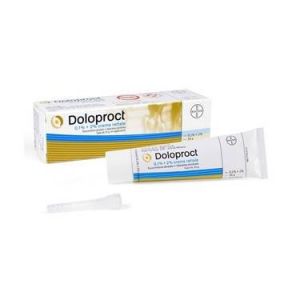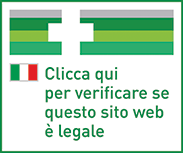Ship in Europe, Find out rates!
Doloproct Rectal Cream Lidocaine Haemorrhoids 30g

- box Delivery in Italy in 24/48 and free returns
- star3.000+ positive reviews
- dropboxOver 60,000 products in the catalog
Cream based on fluocortolone pivalate and lidocaine hydrochloride (anhydrous).
Therapeutic indications
Doloproct Rectal Cream is used for the symptomatic resolution of pain and inflammation in adults in the case of haemorrhoidal diseases, uninfected proctitis and anal eczema.
Dosage and Posology
The drug should be taken according to the following doses and methods: Doloproct rectal cream should be applied twice a day, in the morning and in the evening (up to about 1 g of cream per application). In the first few days of treatment, it can be applied three times a day. To improve symptoms, only one application per day is often sufficient. The total duration of treatment should not exceed 2 weeks.
Doloproct is not recommended for use in children below 18 years of age due to a lack of data on safety and efficacy.
It is advisable to apply Doloproct after defecation. The anal region must be thoroughly cleansed before application. Apply a finger-tip unit of Doloproct rectal cream in the anal region using the tip of the finger to overcome the resistance of the sphincter. A finger-tip unit is the amount of rectal cream squeezed out of the tube and applied to the phalanx surface of an adult's index finger. If Doloproct rectal cream is to be applied inside the rectum, screw the supplied applicator onto the tube and insert the end into the anus. A small amount of cream can then be applied by exerting gentle pressure on the tube.
Overdose
The results of the acute toxicity studies conducted on the active substances of Doloproct show that there is no risk of developing acute toxic symptoms following an accidental overdose after a single rectal or perianal application of Doloproct. Following accidental ingestion of the preparation (for example in the case of ingestion of several grams of cream), the main foreseeable symptoms are the systemic ones attributable to lidocaine hydrochloride which, depending on the dose, can manifest themselves in the form of severe cardiovascular symptoms (depression of the cardiac function or, in extreme cases, cardiac arrest), or central nervous system symptoms (convulsions, dyspnoea or, in extreme cases, respiratory failure).
Treatment of an overdose includes careful monitoring of vital functions, supportive actions including oxygen administration and symptomatic treatment of central and cardiovascular disorders, eg with short-acting barbiturates, betasympathomimetics, atropine. Dialysis is of little use.
Contraindications
Contraindicated in case of topical infections in the area to be treated and if in the affected area there are symptoms attributable to the following pathological pictures:
- specific skin lesions (syphilis, tuberculosis)
- chickenpox
- reactions to vaccines
- genital herpes
- Hypersensitivity to the active substances or to any of the excipients
Side effects
The incidence of undesirable effects was calculated from pooled data from clinical studies involving 661 patients.
- Skin and subcutaneous tissue disorders
- Uncommon (≥1 / 1,000 to <1/100): Allergic skin reactions to any of the excipients.
- General disorders and administration site conditions
- Common (≥1 / 100 to <1/10): Burning at the application site.
- Uncommon (≥1 / 1,000 to <1/100): Irritation at the application site.
After prolonged therapy with Doloproct rectal cream (lasting more than four weeks), there is a risk that patients may develop local skin changes such as atrophy, striae or telangiectasia.
Pregnancy and breastfeeding
There are insufficient data from the use of Doloproct in pregnant women. Animal studies conducted with glucocorticoids have shown reproductive toxicity Some epidemiological studies suggest a possible increased risk of cleft palate in neonates of women who had been treated with systemic glucocorticoids during the first trimester of pregnancy. Cleft palate is a rare disease and, although glucocorticoids are systemically teratogenic, they can only be considered responsible for the increase of one or two cases per 1000 women treated during pregnancy. There are insufficient data on the topical use of glucocorticoids in pregnant women, however a lower risk can be expected, as topical glucocorticoids have a very low systemic bioavailability. As a general rule, topical preparations containing glucocorticoids should not be applied during the first trimester of pregnancy.
In pregnant and lactating women, the clinical indications for treatment with Doloproct rectal cream and the risk / benefit ratio should be carefully considered. In particular, prolonged use should be avoided.
Special warnings
Since Doloproct contains the active substance lidocaine and approximately 30% of the applied dose is available systemically, this should be considered in patients taking medications to treat irregular heartbeat (arrhythmia). In case of application of Doloproct rectal cream to the genital or anal region, the excipients liquid paraffin and white petroleum jelly can reduce the resistance of the latex condoms used at the same time, thus compromising their safety. Care must be taken so that Doloproct does not come into contact with the eyes. It is recommended to wash your hands well after use. Cetostearyl alcohol can cause local skin reactions (e.g. contact dermatitis).
Expiration and retention
Check the expiration date indicated on the package. The expiry date indicated on the package refers to the product in intact packaging, correctly stored. This medicinal product does not require any special storage conditions.
Warning : do not use the medicine after the expiry date indicated on the package.
Composition
100 gr of Doloproct Crema contain:
Active principle
1 mg of fluocortolone pivalate and 20 mg of lidocaine hydrochloride (anhydrous).
Excipients
Polysorbate 60, sorbitan stearate, cetostearyl alcohol, liquid paraffin, white petroleum jelly, sodium edetate, monobasic sodium phosphate dihydrate, disodium phosphate dodecahydrate, benzyl alcohol, purified water.


